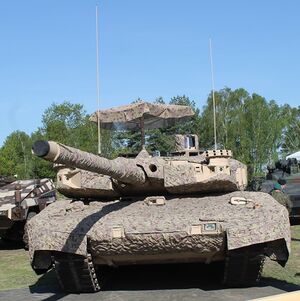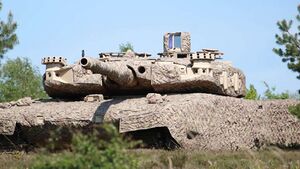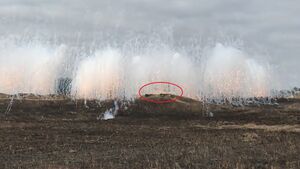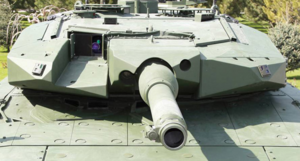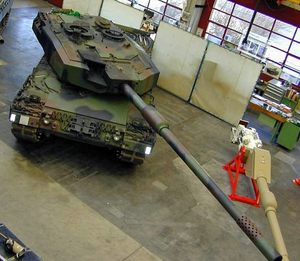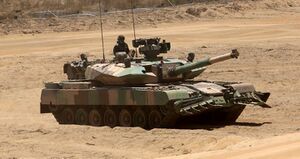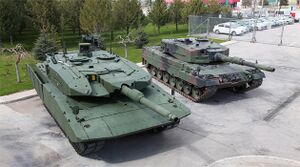CAV-10 Scorpion
This article is incomplete because it is pending further input from participants, or it is a work-in-progress by one author. Please comment on this article's talk page to share your input, comments and questions. Note: To contribute to this article, you may need to seek help from the author(s) of this page. |
| CAV-10 Scorpion | |
|---|---|
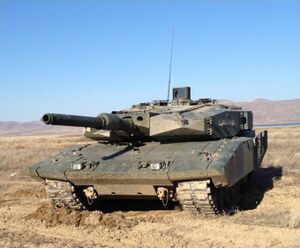 A prototype CAV-10C on cross-country trials in the Ganchow Desert. | |
| Type | Main battle tank |
| Place of origin | |
| Service history | |
| In service | 1979–present |
| Used by | |
| Production history | |
| Designer | Xianzai Arsenal |
| Designed | 1973–1978 |
| Manufacturer | Xianzai Arsenal |
| Unit cost | CL₡10.4 million (FY2014) |
| Produced | 1978–present |
| No. built | >4400 |
| Variants | See Variants |
| Specifications | |
| Weight | 65.0 t (64.0 long tons; 71.7 short tons) |
| Length | 9.7 m (31 ft 10 in) (gun forward) |
| Width | 3.7 m (12 ft 2 in) |
| Height | 2.5 m (8 ft 2 in) |
| Crew | 3 (commander, gunner, driver) |
| Armour | Kamchan composite armour Appliqué ERA (CAV-10B MEP onwards) Slat armour (CAV-10C only) |
Main armament | CAV-10A/CAV-10B: 120 mm L/44 smoothbore gun (42 rounds) CAV-10C: 120 mm L/55 smoothbore gun (42 rounds) |
Secondary armament | 1 × MG-33 12.7 mm machine gun 1 × coaxial MG-61 7.62 mm machine gun |
| Engine | Toyoda DEP-15 multi-fuel diesel engine 1,500 PS |
| Power/weight | 23.1 PS/tonnes |
| Suspension | Hybrid torsion bar and hydropenumatic suspension |
Operational range | 500 km |
| Speed | 70 km/h |
The CAV-10 Scorpion is an advanced 3rd generation main battle tank (MBT) in service with the Supreme Army of Chilokver. Originally developed for the Huliean People's Liberation Army Ground Force (HPLAGF) as the Type 26 main battle tank, it entered service in 1979 as a replacement for the Type 17 and Type 20 tanks then in use. The tank would see action in the 1984 Huliean Civil War, and would be retained by the new army formed when the military dictatorship of Hulie was overthrown & the nation was refounded as the Republic of Chilokver in the same conflict. Since then, the Scorpion has continuously served the Supreme Army of Chilokver as its mainstay MBT thanks to improved production versions and upgrades to in-service vehicles.
Three main variants have been deployed- the original CAV-10A variant, the improved CAV-10B and the latest production model, the CAV-10C. All models feature Kamchan composite armour and are armed with a fully stabilised 120 mm main gun mated to digital fire control systems with laser rangefinders. As a result, the tank has the ability to engage moving targets while moving over rough terrain. The Scorpion is powered by a 1,500 PS multi-fuel diesel engine, with a maximum range of 500 kilometres. At 65 metric tonnes in weight for CAV-10C variant vehicles, the Scorpion is one of the heaviest main battle tanks in service.
History
Development
Operational history
Future and replacement
The Scorpion first entered service in 1979, and has since been upgraded successively into different variants to maintain competitiveness against contemporary MBTs. However, this trend has led to the continual increases in vehicle weight as new variants adopt more armour and equipment. At 65 metric tonnes in weight, the current CAV-10C variant is approaching what most military observers acknowledge as the weight limit for an MBT.
In May 2015, the Chilokveri Ministry of Defence announced plans to develop a tank to replace the Scorpion. Technologies and concepts will be investigated to determine what capabilities are needed in a future tank. Any successor is likely to provide at least the same protection as current MBTs at a lighter weight and offer improvements in lethality. It is believed that the MoD is also seeking foreign partners to develop the new tank with in order to share and reduce costs. Initial deployment of the new tank, which would likely receive the SAC designation of CAV-13, is projected for 2035. Once the new MBT is in service, the current fleet of CAV-10 Scorpions would begin to be retired after over 50 years in continual service.
While the Scorpion remains in service, future improvements are expected to be incremental and focused around changes to the main armament or ammunition only. In the short to mid-term, a lethality increase will come from new digital ammunition types currently under development.
Design
General characteristics
Protection
The measure of a tank's protection is the combination of its ability to avoid detection, to avoid being hit by enemy fire, its resistance to the effects of enemy fire, and its capacity to sustain damage whilst still completing its objective, or at least protecting its crew. Over the course of its development, production and service the CAV-10 Scorpion has incorporated and adopted numerous features for this purpose, making it one of the best protected main battle tanks in service today.
Camouflage and concealment
The CAV-10 Scorpion comes from the factory in a single colour, olive-green paint scheme. Each vehicle is repainted by its unit using a chemical agent resistant coating based upon operational requirements and where the tank is likely to fight. Traditionally this has either been a single colour scheme for low contrast environments such as the desert or snow e.g. desert tan, or a multi-color disruptive camouflage scheme for more cluttered environments. These schemes were effective at reducing visual detection while the vehicle was halted, but served no purpose against infrared and other electromagnetic signatures used in non-visual detection devices. On the CAV-10C, this is rectified with the fitting of the Geodynamica Inc. developed Spectre multi-spectral camouflage system (MCS) which provides concealment against visual, infrared, thermal infrared, and broad-band radar detection. While normally camouflaged tanks were spotted by six spotters over a distance of 2400 metres in trials, vehicles with the benefit of the MCS fitted were only be spotted at a distance of 1600 metres. This 33% relative advantage is due in large part to the fact that it maintains the temperature variance of the vehicle and the surrounding environment to within four degrees Celsius, thus lowering the tank's infrared signature.
The CAV-10A and CAV-10B Scorpion vehicles are also equipped with eight 76 mm, single-shot smoke grenade launchers either side of the turret. The launchers can be electrically fired either singly or in salvos of four to create a thick smokescreen in front of the tank that blocks both visual and thermal imaging. They may also be loaded with flashbang or tear gas rounds for riot control.
Active protection system
The latest variant of the Scorpion, the CAV-10C, is fitted with Xianzai Arsenal's Guardian active protection system, developed with and to equip C-series vehicles. Guardian was designed to be effective against rocket-propelled grenades, 3rd and 4th generation anti-tank guided missiles (including air-launched weapons), as well as "smart" precision-guided cluster munitions. Guardian has also been successfully tested against 120 mm APFSDS rounds during tests in 2007, though intercepted kinetic penetrators still required substantial armour protection to prevent penetration. With an extremely fast reaction time of approximately 560 microseconds, threats up to Mach 5 (1700 m/s) can be consistently eliminated regardless of the distance they were fired from. The APS features no moving parts- instead, sensor and countermeasure modules are arranged in a modular design so as to provide full 360° hemispherical coverage of the vehicle. Guardian uses an integrated, computerized control system which monitors the status and function of all installed modules. In battle, the software can analyze threats and then suggest or automatically take actions to eliminate them without any external instruction from crew members.
The APS integrates two separate sets of countermeasure modules- one soft-kill and one hard-kill, in order to defeat incoming projectiles. Four 40 mm Dynamically Launched Countermeasure (DLC) launcher units mounted on the corners of the turret serve as the soft-kill countermeasures, supplanting the original set of eight 76 mm smoke grenade launchers fitted to the CAV-10A and CAV-10B vehicles. Unlike conventional smoke protection systems, DLC is able to generate dynamic smoke screens to interrupt line of sight (LOS) targeting as the vehicle is moving as well as spontaneous, large-area interruption of LOS. Each launcher unit is fitted with up to 3 magazines containing five 40 mm grenades each. Launchers are triggered automatically once Guardian detects incoming missiles or may alternatively be manually fired by the crew. When fired, the system generates a thick, multi-spectral smoke screen within 0.6 seconds which blocks infrared, visible light and millimeter wave radar.
The hard-kill component of the Guardian APS consists of a Directed Protection System (DPS) of sensor-countermeasure modules arranged all around the vehicle, with overlapping coverage to ensure redundancy. Pre-warning radars serve as preliminary sensors, which then activate primary electro-optical sensor units. These main sensor units then, in conjunction with a processor, determine the type and trajectory of projectile. If determined as a valid target i.e. the projectile poses a threat, will impact the vehicle and is able to be nullified by the APS, then a countermeasure close to the predicted point of impact is activated to defeat it immediately before impact. Unlike traditional active protection systems, which typically use a launcher-based system to fire a rocket or fragmentation blast—in effect a "rocket-propelled shotgun"—in order eliminate incoming threats, DPS instead uses non-fragmenting, directed energy, steered via laser ignition. As a result, collateral damage to nearby friendly troops or civilians is minimized, making Guardian especially suited for urban warfare environments. The system also notifies the tank's crew of the location that the projectile came from, allowing them to fire back quickly after the APS has automatically intercepted it.
The Guardian APS was extensively tested by the SAC as part of its integration process with the CAV-10C, during which all program requirements were met or even exceeded. Testing included live-fire demonstrations where different types of RPGs and ATGMs were launched at various spots like the sides or the roof from close range (~15 metres). During these tests, the APS' threat rejection and multi-hit capability were proven, notably in a test simulating an urban ambush where 7.62 mm rounds and RPGs were fired from a short distance of some 50 m at an immobile vehicle. The active protection system correctly identified the direction of hostile fire, suggested its DLC deploy a smokescreen and successfully intercepted two RPGs fired simultaneously thus proving its ability to handle multi-hit attacks intended to overwhelm the APS. The system also detected a third, missed RPG but rejected it as a threat and similarly ignored 7.62 mm rounds fired at the tank. Operation in hot or monsoonal conditions without failure or false positives was also confirmed.
Armour
The CAV-10 Scorpion features Kamchan composite armour throughout its design. While exact details are classified, public information indicates that the armour consists of ceramic tiles embedded within a metal matrix and further reinforced by additional layers of composite materials, elastic layers and a backing plate. Due to the extreme hardness and brittleness of the ceramics involved, kinetic penetrators and shaped charge jets are strongly disrupted or shattered. Additional layers such as rubber or heavy metals are designed to offer further resistance and defeat penetrators. Successive variants have seen improved generations of Kamchan armour- from the CAV-10B onwards, the armour has been backed by depleted uranium mesh for added protection against kinetic energy penetrators. Current iterations are believed to utilise such materials as silicon carbide tiles, graphite matrices and titanium alloys to improve protection while keeping weight as low as possible.
The CAV-10C has seen the addition of explosive reactive, slat and appliqué Kamchan armour modules, designed to increase protection on the top, sides and rear of the tank. Explosive reactive armour (ERA), which uses sheets of explosive sandwiched between sheets of metal to shear apart kinetic penetrators and disrupt shaped jets, was added as a necessary upgrade against improved shaped charge and APFSDS rounds. The 3rd generation Shahid ERA featured on the Scorpion is designed to defeat tandem charge HEAT warheads and existing kinetic energy penetrators. As with the appliqué Kamchan armour, these modules are designed to be easily and quickly replaced in the field should they be damaged.
The turret and extended frontal arc of the CAV-10C Scorpion are designed to defeat contemporary 120 mm to 125 mm APFSDS & HEAT rounds and/or portable anti-tank missiles. The sides and rear of the tank resist against medium caliber autocannon fire, heavy machine guns and all other firearms. They are also protected against rocket propelled grenades through the mounting of heavy ballistic skirts towards the front half, and slat armour towards the rear. For increased protection against mines and IEDs, the hull floor is sloped and corrugated, with an additional piece of V-shaped armour on the bottom of the tank to deflect blasts. Protection against spalling is provided by a Kevlar liner.
While armour values for tanks currently in service are classified, the armour of the CAV-10A is believed to provide a maximum protection approximately equivalent to 900 mm of rolled homogenous armour against kinetic energy penetrators and 1000 mm of rolled homogenous armour equivalent (RHAe) against shaped charge warheads. Based upon publicly available values for the CAV-10A's dimensions, estimates for the physical thickness of its armour range from 660–860 mm line of sight (LOS) on the turret to 650 mm LOS on the glacis and lower front hull.
Crew protection features
In addition its armour, the CAV-10 Scorpion was designed with numerous features for the protection of its crew. The Scorpion follows the principle of compartmentalisation in isolating sources of fire or explosion from the crew to prevent their injury. The engine and transmission is separated from the crew compartment through a fireproof bulkhead. The ammunition and turret hydraulics are also located in compartments separated from the crew. For example, the main gun's ready magazine occupies the rear section of the turret, with blast doors that open under power by sliding sideways only to remove a round for firing, then automatically close. In case of a detonation, the blow-off panels on these compartment roofs will direct the explosion and fire away from the crew, protecting them from the risk of the tank's own ammunition cooking off or exploding if the tank is damaged.
The CAV-10 Scorpion is equipped with an automatic fire suppression system. Four 9 kg Halon fire extinguisher bottles are installed on the right behind the driver's station. The bottles are connected to pipes and hoses and are activated automatically by the fire detection system, when temperatures rise above 82 °C (180 °F) inside the fighting compartment, or manually via a control panel in the driver's compartment. An extra 2.5 kg Halon fire extinguisher is stored on the floor beneath the main gun.
The crew is also protected against nuclear, biological and chemical (NBC) threats, as the Scorpion is equipped with a NBC overpressurization system, which provides up to 4 millibars (4.0 hPa) of over-pressure inside the vehicle. This prevents airborne particles from entering the sealed crew compartment, which then only receives safe air which has been filtered of NBC threats.
Armament
Primary
The Scorpion mounts an indigenously developed 120 mm smoothbore gun produced by Chilokveri Steel Works as its primary armament. The CAV-10A and CAV-10B mount a 44 caliber long variant of this gun, while the CAV-10C mounts a 55 caliber long variant with increased range and muzzle velocity. The barrel is made of electro-slag refined steel and electro-plated with chromium, giving a service life of 1,500 effective full charges before needing replacement. Barrels are insulated with a glass-reinforced plastic thermal sleeve, and feature a bore evacuator of the same material. The gun is fully stabilised, and has a recoil mechanism consisting of two hydraulic retarders and a hydropneumatic assembly. Total weight is approximately 3,475 kilograms. The main gun has an elevation range of +20° to −9°, which is increased to a range of +30° to -15° with adjustment of the tank's active suspension.
Ammunition is loaded by a chain autoloader, with a maximum fire rate of 12 rounds per minute. 20 rounds are stored in a ready magazine in the turret, with another 22 in a secondary magazine in the hull for a total capacity of 42 rounds. Both magazines are equipped with blow-out panels designed to vent the force of an explosion up and out of the crew compartment. Rounds are identified by the autoloader using embedded RFID chips, and visually by nose cone color.
In service, the CAV-10 Scorpion carries a mixture of indigenously developed SCAR (SCorpion ARmament) munitions, including APFSDS, multipurpose HEAT rounds and guided anti-vehicle missiles. The typical allotment is believed to be 26 SCAR 1.4, 10 SCAR 2.2 and 6 SCAR 3.1 rounds.
- SCAR 1.4: The SCAR 1.4 is a 5th generation armour-piercing, fin-stabilised, discarding sabot (APFSDS) round designed for use against enemy tanks and heavy armour, in particular those protected by ERA. The round is designed around a 10 kg, 800 mm jacketed depleted uranium penetrator encased in a 3-petaled composite sabot. The flight projectile consists of a windshield, tip assembly and low drag fins with tracer. Total weight for a SCAR 1.4 round is estimated at ~23 kg. The SCAR 1.4 is estimated to have a muzzle velocity of over 1,800 m/s, a RHA penetration of greater than 850 mm at 2 kilometres range and a maximum effective range of over 4,000 m.
- SCAR 2.2: The SCAR 2.2 is a 3rd generation multi-purpose shaped-charge round designed for use against enemy vehicles, personnel and fortifications. The SCAR 2.2 features a tandem charge warhead, and a programmable multipurpose fuse which can be set to proximity, contact or post penetration detonation. The warhead weighs over 11 kg, while total weight is estimated at 22 kg. The round has a muzzle velocity of over 1000 m/s, a RHA penetration of approximately 500 mm and a maximum effective range of ~4000 m.
- SCAR 3.1: The SCAR 3.1 is a second generation gun-launched guided missile designed for use against enemy vehicles and rotorcraft. The missile is semi-active laser homing, and may be guided by the tank itself, or indirectly via other platforms e.g. other tanks, helicopters, UAVs etc. The round is capable of altering its flight path for either top attack (anti-armour) or direct guidance (anti-helicopter) engagements. Altogether, the munition achieves a 95% kill probability as a result of its guidance systems and high accuracy (estimated at 0.7 m CEP). The missile mounts a 4.5 kg tandem charge warhead, with a total weight of 16.5 kg. The SCAR 3.1 has a top speed of approximately 300 m/s, a RHA penetration of approximately 900 mm and a maximum effective range of 8 kilometres.
An experimental CAV-10B vehicle was mounted with a 140 mm main gun for testing purposes in 1985. The larger gun promised up to twice as much penetration as the CSW 120/L44, which would have enabled the Scorpion to comfortably defeat current and future tank designs. However, the weapon was a new, unproven design and the larger 140 mm two-piece ammunition meant that less rounds could be carried. Ultimately, the attempt to up-gun the Scorpion was abandoned in order to meet the deadlines for the production of the CAV-10B.
Fire control systems
Secondary
In addition to the 120 mm main gun, all models of the CAV-10 Scorpion are equipped with a secondary armament of two machine guns. A MG-61 7.62 mm general purpose machine gun (GPMG) is mounted coaxially to the left of the main gun for use against infantry and other soft targets, while a pintle-mounted 12.7 mm MG-33 heavy machine gun (HMG) placed on the commander's hatch ring on the roof of the tank provides defence against hardened or low-flying aerial targets. The former has an effective range of 1,300 m and the latter an effective range of 1,800 m.
The coaxial GPMG is aimed and fired using the same interface & computerised fire control system (FCS) as the main gun, typically by the gunner or in override mode, the commander. On the other hand, the 12.7 mm HMG on CAV-10A & CAV-10B variants requires it be manually aimed by the commander using the MG-33's iron sights, who must expose their upper torso to use the weapon. On the CAV-10B MEP and CAV-10C variants, the MG-33 is mounted on a Xianzai Arsenal Killstreak remote weapon station (RWS), allowing the commander to use the machine gun without having to expose themselves outside of the tank. The Killstreak is integrated into the Scorpion's fire control system and normally uses the commander's periscope for sighting purposes with its own sensors & FCS serving as backup. In a similar fashion to the coaxial machine gun, the RWS is thus capable of being used by either the commander or if necessary the gunner from their own user interfaces. The Killstreak is also capable of mounting a 7.62 mm machine gun or a 40 mm grenade launcher instead of the 12.7mm HMG.
400 rounds of 12.7 mm ammunition are stored ready to fire on the RWS, with a further 400 stowed within the hull for a total of 800 rounds. This compares with 100 loaded, 900 stored and 1,000 total rounds on CAV-10A & CAV-10B mounted MG-33s. The coaxial MG-61 machine gun is provided with 8,000 rounds of 7.62 mm ammunition- 2,800 in a ready box next to the main gun, 2,000 in the gunner's foot box and a further 3,200 rounds stowed in boxes around the bustle rack.
Sensors and electronics
Mobility
Operational
The CAV-10 Scorpion's powertrain consists of a Toyoda DEP-15 multi-fuel diesel engine coupled to a Toyoda SCYH 983 semi-automatic transmission with four forward and two reverse gears. The DEP-15 is a four-stroke, 12-cylinder, twin-turbocharged & intercooled diesel engine which provides 1,500 metric horsepower (1,119 kW) at 2,600 rpm and 4,700 N⋅m (3,467 lb⋅ft) of torque at 1,600-1,700 rpm. The powerpack features good mechanical reliability and can be changed in the field in under 35 minutes if needed. Estimated combat fuel consumption rate is approximately 300 litres per 100 km on road and 500 litres per 100 km across country. The Scorpion has four fuel tanks with a total capacity of 1,160 litres, giving it a maximum road range of about 500 km.
On the CAV-10C and GI Scorpion variants, fuel consumption during operations is further reduced by an installed Toyoda GTK-20 gas turbine auxiliary power unit (APU) which eliminates idle fuel consumption. The APU produces 20 kW (27 PS), with which all onboard systems i.e. weapons & turret drives, sensors & communications, NBC & air conditioning etc. can be powered while the tank is stationary, allowing the main engine to be shut down and thus saving fuel.
A version of the Toyoda PowerPack Kai with a 1,600 PS (1,214 kW) Toyoda DEP-16 diesel engine and Toyoda MCSH 993 transmission with five forward & three reverse gears was also trialled by the CAV-10B Scorpion during studies for the Midlife Extension Programme. Compared to the current powertrain, the PowerPack Kai is more fuel-efficient, generates more power and requires less space. However, powerpack upgrades were shelved for both the CAV-10B MEP and CAV-10C variants, making it unlikely any PowerPack Kai equipped Scorpions will enter service in the future.
The running gear consists of 7 dual rubber-tyred road wheels & four return rollers per side, with the idler wheel at the front and drive sprocket at the rear. Torsion bar suspension is used on the 3rd through to 5th pairs of road wheels, with advanced friction dampers supplemented by hydraulic bump stops. The first, second and last pair of road wheels mount hydropneumatic suspension units, which can be adjusted on-the-fly to deal with uneven terrain. The hydropneumatic suspension also allows the tank to actively raise and lower its profile as necessary. By adjusting its suspension in this way, the Scorpion is capable of increasing its gun elevation range by 50%. The Scorpion uses live track, with rubber-bushed end connectors, 82 manganese-steel links per track & removable rubber pads. For operation in icy terrain, up to 18 rubber pads can be replaced with the same number of grousers, which are stored in the tank's bow when not in use.
The CAV-10 can cross water up to 1.2 metres deep without any preparation. With the equipping of an optional snorkel system, which also serves as a conning tower for the tank commander, the tank can wade through water up to 4 metres deep. However, due to the vehicle's heavy weight (65 metric tonnes for the CAV-10C), only an estimated 40% or less of bridges worldwide are able to support crossings by Scorpions. Similarly, their size and weight limit them to being moved only by rail, on strategic airlifters and/or specialised transporters.
Tactical
The CAV-10C Scorpion possesses a power-to-weight ratio of 23.1 hp/tonne, and is capable of a governed top speed of 70 km/h on road & up to 50 km/h sustained in cross-country terrain. Maximum reverse speed is 31 km/h. Official Chilokveri Ministry of Defence reports list the Scorpion's acceleration as under 7.5 seconds from 0 to 32 km/h. The Scorpion is able to cross trenches up to 3 m wide. While the CAV-10C is almost 10 tonnes heavier compared to the original CAV-10A, its mobility has not been degraded thanks to improved suspension components. The CAV-10C is able to negotiate terrain with up to 60-degree slope and 30-degree side slope, and climb vertical obstacles up to 1.15 m in height. Specific ground pressure is 0.96 kg/cm2 for the CAV-10C, and all variants possess a ground clearance of 487 mm.
Variants and derivatives
Variants
- CAV-10A – Introduced in 1979 as the Type 26 tank, the CAV-10A were the first production series of Scorpion MBTs. Early vehicles were at first equipped with a low-light imager. This was later replaced on subsequent production vehicles with a thermal imager, which was then retrofitted onto older tanks. Subsequent additions and retrofits included digital radios and coverplates for the sights & NBC system.
- CAV-10 GI - First shown in 2013, the CAV-10 GI Scorpion is an independently developed after-market upgrade for A-series Scorpion MBTs designed by Geodynamica Inc. Aimed primarily at the export market, the GI Scorpion offers similar capabilities to advanced third-generation MBTs at a lower cost. In order to preserve the Scorpion's mobility as originally designed, weight was limited to a maximum of 60 tonnes, compared to the CAV-10A's original 56.6 tonnes. The majority of this allowance (~3 tonnes) was allocated to nanoceramic-alloy composite armour modules added to the front and sides of the turret. No armour was added around the hull, but hull floor protection against mines & improvised explosive devices (IEDs) was improved. Improved NBC and fire suppression systems were also installed. The GI Scorpion retains the armaments of its predecessor with only minimal changes e.g. replacement of hydraulic turret drives with electric drives. Sensors and fire control are upgraded to a modern standard but no additional battlefield management/communications systems were installed. The GI Scorpion also adds the same GTK-20 gas turbine APU as the CAV-10C variant. As of 2021, no orders have been placed for the CAV-10 GI.
- CAV-10B – From this variant onwards, the steel matrix comprising part of the Kamchan armour was replaced with a titanium alloy, with the weight savings being applied back in the form of depleted uranium armour. Other notable changes to the armour included modifications to the turret face & thickness. Crew safety was greatly increased with an improved NBC system and automated fire suppression. New digital fire control systems & communications equipment were also fitted.
- CAV-10B MEP - While an equal to contemporary MBTs when debuted in 1986, it was clear by the early 2000s that the CAV-10B was increasingly at risk of obsolescence against foreign designs. As a stop gap measure before the CAV-10C was introduced, the Chilokveri Ministry of Defence began a series of upgrades for the CAV-10B, collectively known as the Midlife Extension Programme or MEP. The programme aimed at optimising the Scorpion for urban combat & unconventional warfare, which were predicted to make up an increasingly large portion of future conflicts and in which tanks have traditionally performed poorly. A mine plough attachment and 5 new towing points were added, while the 12.7 mm machine gun was instead swapped with a remote weapons station capable of mounting either a 12.7 mm HMG or a 40 mm automatic grenade launcher. The upgrades also addressed the threat of infantry attacks using RPGs & rockets through the fitting of Martyr ERA across the turret. To counter the increased risk of mines and IEDS, the hull was reworked with an additional V-shaped piece of armour and the floor corrugated for extra strength. While primarily optimised for urban combat, the MEP also improved overall performance with the introduction of all-electric turret controls and a separate commander's thermal sight.
- CAV-10C – The current, and latest model of the Scorpion to be produced. First introduced in 2011, C-series Scorpions can be distinguished from the previous variants by their distinctly different silhouettes- additional Kamchan and explosive reactive armour modules were added across the hull and turret, significantly improving protection at the cost of increasing weight to 65.0 tons. Hull protection was improved with additional armour, as well as active mine countermeasures. Toughened skirts and additional spall liners were also installed, while armament improvements consisted of a new 55 caliber main gun and upgraded optics & sensors. The CAV-10C saw the introduction of active protection systems on the Scorpion for the first time with the equipping of the Guardian APS.
Derivatives
- CAV-10 Scorpling (Driver Training Tank) – Hulls from the initial production batch of CAV-10As were set aside for driver training purposes, with the modified vehicles being designated as CAV-10 Scorplings. The turret is replaced by a weighted and fixed observation cab with forward and side-facing windows and a dummy gun. The instructor rides in this cab, with override controls for critical systems, with space for two other students to observe.
- CAV-55 Emperor (ARV) – With the introduction of the CAV-10 Scorpion, the previous CAV-50 Badge armoured recovery vehicle (ARV), based upon the CAV-1 Huntsman, was no longer powerful enough to support the new battle tank and development for a new replacement based upon the same chassis & powerpack as the Scorpion was launched. First delivered in early 1990, the CAV-55 Emperor mounts a crane, winch and front-mounted bulldozer blade, allowing it to recover damaged, or immobilised vehicles. The crane is mounted on a large rotary platform capable of traversing 270 degrees and is capable of lifting up to 30 tonnes, allowing it to lift the turret or powerpack of any other armoured vehicles. The Emperor ARV carries a spare powerpack at the rear of the hull, and can replace the powerpack of a Scorpion in 25-35 minutes, depending on the variant of the tank. The mechanical winch is provided with 180 m of cable and has a traction force of up to 70 tonnes with the help of pulley blocks. Once recovered, the Emperor can tow a vehicle up to 62 tonnes in weight back to maintenance units. The dozer blade is used to stabilise the vehicle during craning and winching operations. It also fulfills general dozing and obstacle removal missions. The Emperor carries a single 7.62 mm machine gun for self-defense, plus smoke grenade launchers. The vehicle has an automatic fire suppression and NBC system to protect its crew of 3.
- CAV-56 Deathstalker (AVLB) – The CAV-56 Deathstalker is a development of the Scorpion chassis designed to carry, launch and retrieve a folding assault bridge. Designed in 1999, the first production Deathstalkers began replacing the aging CAV-52 Badge AVLBs in 2002. Instead of a turret, the Deathstalker carries a launching mechanism for three bridge modules. The bridge is laid horizontally (cantilever style) rather than vertically as with a number of other AVLBs, the main advantage of such a design being that it can not be observed some distance away by the enemy. Bridge modules are of a welded aluminum alloy construction, each being 9.7 metres long and weighing approximately 4.8 tonnes. Modules can be laid coupled together, or individually. Two modules form an 18.7 m long bridge, while the overall length with all three coupled is 28.7 m. It is also possible to launch three bridges of 9.7 m lengths. A short bridge is laid within three minutes and it takes eight minutes to launch the complete bridge. Stabilisers are lowered to the ground at the front of the vehicle while the bridges are being launched. Once emplaced, the bridge is sturdy enough to support most vehicles, even other Scorpion tanks. When the crossing is complete, the bridge-layer simply hooks up to the bridge and re-stows it.
- CAV-58 Redclaw (AEV) – This armoured engineering vehicle (AEV) conversion of the CAV-10A Scorpion was developed by Geodynamica Inc. and co-produced with Xianzai Arsenal. CAV-10A vehicles were first stripped by Xianzai Arsenal, with the stripped hulls then being converted to AEV configuration by Geodynamica Inc. through the retrofitting of crew modules and fixtures for other equipment. The vehicle is used primarily for the clearance of obstacles (including minefields). The vehicle is equipped with a bulldozer blade, hinged arm excavator and two 9 tonne capstan winches. The excavator is equipped with a quick-change tool system for fitting other tools, such as a universal gripper, a hydraulic hammer and a concrete crusher. Bulldozing capacity of the vehicle is 350 m3/h. The blade can be substituted with a mine plough as part of a mine-breaching kit when required, which also includes a lane marking system and magnetic signature device. As a result of the conversions, the Redclaw has no turret. Instead, a Killstreak remote weapon station carrying a 12.7 mm machine gun or 40 mm automatic grenade launcher is fitted. A smoke grenade launcher system is also fitted. The Redclaw is equipped with a nuclear-biological-chemical (NBC) suite and a integrated mine protection kit.
Operators
Current operators
 Republic of Chilokver
Republic of Chilokver
 Supreme Army of Chilokver – The Supreme Army of Chilokver currently operates 3,250 Scorpions of the CAV-10C, CAV-10B MEP and CAV-10B variants in active service, with a further 648 CAV-10Bs being operated by the SAC Reserve Corps. Approximately 1,100 CAV-10A and CAV-10B tanks have been retained in long term storage. In September 2018, the Chilokveri Ministry of Defence placed an order for 200 more CAV-10Cs, which would bring the total number of CAV-10Cs in Chilokveri service to 1,145 vehicles by the end of 2022.
Supreme Army of Chilokver – The Supreme Army of Chilokver currently operates 3,250 Scorpions of the CAV-10C, CAV-10B MEP and CAV-10B variants in active service, with a further 648 CAV-10Bs being operated by the SAC Reserve Corps. Approximately 1,100 CAV-10A and CAV-10B tanks have been retained in long term storage. In September 2018, the Chilokveri Ministry of Defence placed an order for 200 more CAV-10Cs, which would bring the total number of CAV-10Cs in Chilokveri service to 1,145 vehicles by the end of 2022.
 Republic of New Cambria
Republic of New Cambria
- Army of the Republic of New Cambria – The Army of the Republic of New Cambria ordered 164 CAV-10A (known in New Cambrian service as the M10A1 Wayland) main battle tanks from Xianzai Arsenal in 1987. Of these 132 MBTs, approximately 96 have since been upgraded to CAV-10C variant (known in New Cambrian service as M10A2).
Former operators
 People's Republic of Hulie
People's Republic of Hulie
 Huliean People's Liberation Army Ground Force – 735 Type 26 tanks were in service with the Huliean People's Liberation Army Ground Force in 1984. All were passed onto the Supreme Army of Chilokver and redesignated as the CAV-10A when the Executive Junta of Hulie was overthrown and the nation was refounded as the Republic of Chilokver.
Huliean People's Liberation Army Ground Force – 735 Type 26 tanks were in service with the Huliean People's Liberation Army Ground Force in 1984. All were passed onto the Supreme Army of Chilokver and redesignated as the CAV-10A when the Executive Junta of Hulie was overthrown and the nation was refounded as the Republic of Chilokver.
